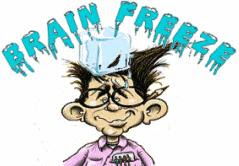Ever heard of "sphenopalatine ganglion"?
Brain freeze, primarily known as ice cream headache, but also cold headache, shakeache, frigid face, freezie, frozen brain syndrome, cold-stimulus headache, or its given scientific name sphenopalatine ganglioneuralgia (meaning "nerve pain of the sphenopalatine ganglion"), is a form of brief cranial pain or headache commonly associated with consumption (particularly quick consumption) of cold beverages or foods such as ice cream.
its given scientific name sphenopalatine ganglioneuralgia (meaning "nerve pain of the sphenopalatine ganglion"), is a form of brief cranial pain or headache commonly associated with consumption (particularly quick consumption) of cold beverages or foods such as ice cream.
An editorial was published in the British Medical Journal on ice cream headache; it referenced several articles on the effect of rapid consumption of cold foods or beverages. It has been studied as an example of referred pain, an unpleasant sensation localized to an area separate from the site of the painful stimulation.
The effect occurs when something very cold, such as ice cream, touches the top palate in the mouth. The blood vessels constrict due to the cold. This makes the nerves send a signal to the brain to open blood vessels. But this rapid opening of the blood vessels makes fluid back up in the tissues that won't drain for thirty seconds to a minute. This causes a little swelling in the forehead that hurts a lot.
It has been estimated that one in three people experience ice cream headache from consumption of ice cream. Some studies suggest that it is more common in people who experience migraines; other studies have shown the opposite. Experiments have shown that frozen yogurt, which will generally maintain a more liquid state than traditional ice cream at lower temperatures, will trigger ice cream headache in test subjects more readily than dairy ice cream, cold drinks or ice.
The term "Brainfreeze" has been trademarked by 7-Eleven.
Brain freeze, primarily known as ice cream headache, but also cold headache, shakeache, frigid face, freezie, frozen brain syndrome, cold-stimulus headache, or
 its given scientific name sphenopalatine ganglioneuralgia (meaning "nerve pain of the sphenopalatine ganglion"), is a form of brief cranial pain or headache commonly associated with consumption (particularly quick consumption) of cold beverages or foods such as ice cream.
its given scientific name sphenopalatine ganglioneuralgia (meaning "nerve pain of the sphenopalatine ganglion"), is a form of brief cranial pain or headache commonly associated with consumption (particularly quick consumption) of cold beverages or foods such as ice cream.An editorial was published in the British Medical Journal on ice cream headache; it referenced several articles on the effect of rapid consumption of cold foods or beverages. It has been studied as an example of referred pain, an unpleasant sensation localized to an area separate from the site of the painful stimulation.
The effect occurs when something very cold, such as ice cream, touches the top palate in the mouth. The blood vessels constrict due to the cold. This makes the nerves send a signal to the brain to open blood vessels. But this rapid opening of the blood vessels makes fluid back up in the tissues that won't drain for thirty seconds to a minute. This causes a little swelling in the forehead that hurts a lot.
It has been estimated that one in three people experience ice cream headache from consumption of ice cream. Some studies suggest that it is more common in people who experience migraines; other studies have shown the opposite. Experiments have shown that frozen yogurt, which will generally maintain a more liquid state than traditional ice cream at lower temperatures, will trigger ice cream headache in test subjects more readily than dairy ice cream, cold drinks or ice.
The term "Brainfreeze" has been trademarked by 7-Eleven.
*Wikipedia

No comments:
Post a Comment